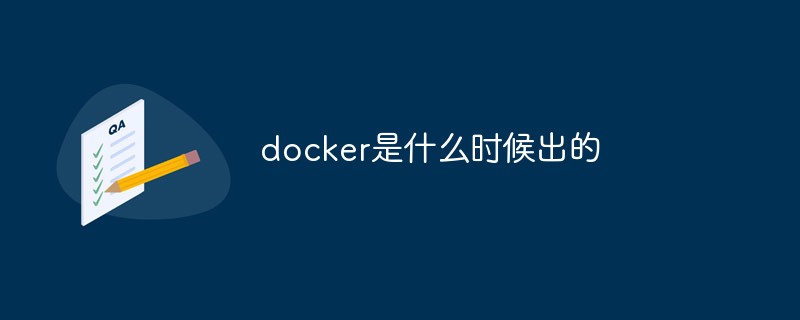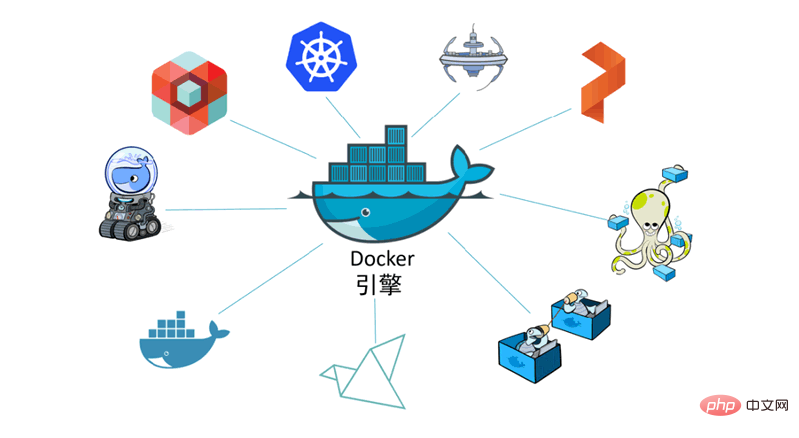When did docker come out?
Docker was released in 2013. The source code is hosted on Github. It is based on the go language and complies with the Apache2.0 protocol and is open source. It is an advanced container engine based on LXC open sourced by the PaaS provider dotCloud. It is an Tools to easily create, deploy, and run applications with containers.

The operating environment of this tutorial: linux7.3 system, docker-1.13.1 version, Dell G3 computer.
When did docker come out?
Docker is a software that runs on Linux and Windows and is used to create, manage, and orchestrate containers.
Docker is part of the Moby open source project developed on GitHub.
Docker Company, located in San Francisco, is the maintainer of the entire Moby open source project. The Docker Company also offers a commercial version of Docker that includes support services.
Docker Company
Docker Company is located in San Francisco and was founded by French-American developer and entrepreneur Solumon Hykes. Its logo is shown in the picture below.
Docker logo

Interestingly, Docker company was originally a Platform-as-a-Service (PaaS) called dotCloud provider.
In terms of underlying technology, the dotCloud platform utilizes Linux container technology. To make it easier to create and manage these containers, dotCloud developed a set of internal tools, later named "Docker." This is how Docker was born!
In 2013, dotCloud’s PaaS business was not doing well, and the company needed to seek new breakthroughs. So they hired Ben Golub as the new CEO, renamed the company "Docker", abandoned the dotCloud PaaS platform, and started a new journey with the mission of "promoting Docker and container technology to the world".
Today Docker is widely regarded as an innovative technology company, with a market value said to be approximately $1 billion. Docker has attracted a total of more than $240 million in investment from several Silicon Valley venture capital firms through multiple rounds of financing.
Almost all of the financing occurred after the company changed its name to "Docker".
Tip: The word "Docker" comes from the British colloquial word, which means dock worker (Dock Worker), that is, a person who loads and unloads goods from a ship.
Docker runtime and orchestration engine
When most technical people talk about Docker, they mainly refer to the Docker engine.
Docker Engine is the infrastructure tool for running and orchestrating containers. Readers with VMware management experience can compare this to ESXi.
ESXi is the core hypervisor that runs virtual machines, and Docker Engine is the core container runtime that runs containers.
Other Docker companies or third-party products are developed and integrated around the Docker engine.
As shown in the figure below, the Docker engine is at the center, and other products are integrated based on the core functions of the Docker engine.

Products developed and integrated around the Docker engine
The Docker engine can be downloaded from the Docker website or built based on the source code on GitHub. Both open source and commercial versions are available for Linux and Windows.
There are two main versions of Docker engine: Enterprise Edition (EE) and Community Edition (CE).
Every quarter, the Enterprise Edition and Community Edition will release a stable version. The community edition comes with 4 months of support, while the enterprise edition comes with 12 months of support.
Publish the monthly version via Edge.
Starting in the first quarter of 2017, Docker version numbers follow the YY.MM-xx format, similar to projects such as Ubuntu. For example, the first community version released in June 2018 was 18.06.0-ce.
Recommended learning: "docker video tutorial"
The above is the detailed content of When did docker come out?. For more information, please follow other related articles on the PHP Chinese website!

Hot AI Tools

Undresser.AI Undress
AI-powered app for creating realistic nude photos

AI Clothes Remover
Online AI tool for removing clothes from photos.

Undress AI Tool
Undress images for free

Clothoff.io
AI clothes remover

Video Face Swap
Swap faces in any video effortlessly with our completely free AI face swap tool!

Hot Article

Hot Tools

Notepad++7.3.1
Easy-to-use and free code editor

SublimeText3 Chinese version
Chinese version, very easy to use

Zend Studio 13.0.1
Powerful PHP integrated development environment

Dreamweaver CS6
Visual web development tools

SublimeText3 Mac version
God-level code editing software (SublimeText3)

Hot Topics
 1387
1387
 52
52
 How to update the image of docker
Apr 15, 2025 pm 12:03 PM
How to update the image of docker
Apr 15, 2025 pm 12:03 PM
The steps to update a Docker image are as follows: Pull the latest image tag New image Delete the old image for a specific tag (optional) Restart the container (if needed)
 How to use docker desktop
Apr 15, 2025 am 11:45 AM
How to use docker desktop
Apr 15, 2025 am 11:45 AM
How to use Docker Desktop? Docker Desktop is a tool for running Docker containers on local machines. The steps to use include: 1. Install Docker Desktop; 2. Start Docker Desktop; 3. Create Docker image (using Dockerfile); 4. Build Docker image (using docker build); 5. Run Docker container (using docker run).
 How to exit the container by docker
Apr 15, 2025 pm 12:15 PM
How to exit the container by docker
Apr 15, 2025 pm 12:15 PM
Four ways to exit Docker container: Use Ctrl D in the container terminal Enter exit command in the container terminal Use docker stop <container_name> Command Use docker kill <container_name> command in the host terminal (force exit)
 How to copy files in docker to outside
Apr 15, 2025 pm 12:12 PM
How to copy files in docker to outside
Apr 15, 2025 pm 12:12 PM
Methods for copying files to external hosts in Docker: Use the docker cp command: Execute docker cp [Options] <Container Path> <Host Path>. Using data volumes: Create a directory on the host, and use the -v parameter to mount the directory into the container when creating the container to achieve bidirectional file synchronization.
 How to view the docker process
Apr 15, 2025 am 11:48 AM
How to view the docker process
Apr 15, 2025 am 11:48 AM
Docker process viewing method: 1. Docker CLI command: docker ps; 2. Systemd CLI command: systemctl status docker; 3. Docker Compose CLI command: docker-compose ps; 4. Process Explorer (Windows); 5. /proc directory (Linux).
 How to check the name of the docker container
Apr 15, 2025 pm 12:21 PM
How to check the name of the docker container
Apr 15, 2025 pm 12:21 PM
You can query the Docker container name by following the steps: List all containers (docker ps). Filter the container list (using the grep command). Gets the container name (located in the "NAMES" column).
 How to save docker image
Apr 15, 2025 am 11:54 AM
How to save docker image
Apr 15, 2025 am 11:54 AM
To save the image in Docker, you can use the docker commit command to create a new image, containing the current state of the specified container, syntax: docker commit [Options] Container ID Image name. To save the image to the repository, you can use the docker push command, syntax: docker push image name [: tag]. To import saved images, you can use the docker pull command, syntax: docker pull image name [: tag].
 How to start mysql by docker
Apr 15, 2025 pm 12:09 PM
How to start mysql by docker
Apr 15, 2025 pm 12:09 PM
The process of starting MySQL in Docker consists of the following steps: Pull the MySQL image to create and start the container, set the root user password, and map the port verification connection Create the database and the user grants all permissions to the database




